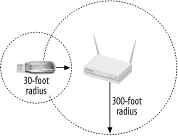6.1 Bluetooth Standards Today
| Bluetooth is a wireless communication technology that is designed for short-range, point-to-point data transfer. Like infrared, Bluetooth is well suited for ad-hoc applications where the presence of a network infrastructure is not available. However, unlike infrared, Bluetooth does not have the limitation of requiring line of sight for communication. Bluetooth uses radio waves in the 2.4 GHz band. Coincidentally, this is also the band used by 802.11b and 802.11g devices. Unfortunately, a lot of domestic appliances also use this 2.4 GHz band, most notably cordless phones and microwave ovens. This means that this 2.4 GHz frequency band (also known as Industrial, Scientific, and Medical, or ISM) is crowded (see Interference Between Bluetooth and Other Devices in this chapter).
To minimize the impact of interference, Bluetooth uses a technique called Spread Spectrum Frequency Hopping . The actual frequency range used by a Bluetooth device is from 2.402-2.480 GHz. Within this range, Bluetooth devices "hop" between the different frequencies with a 1 MHz interval. This essentially gives Bluetooth devices 79 different frequencies to choose from. During a data transfer, the data is divided into packets. Each packet can be sent or received using any of the 79 different frequencies. Per the Bluetooth specification, Bluetooth devices can make up to 1600 hops per second. This essentially reduces the chance that a device will be "jammed" in a fixed frequency. (If the device is experiencing too much interference on the current frequency, you can be sure that it will look for a less busy one in a fraction of a second.) 6.1.1 PiconetWhen two Bluetooth devices connect to each other, they create a network called a piconet. A piconet contains a master and one or more slaves. Any device can take the role of a master. The device that initiates the connection (the one that found the other device) is the master. Figure 6-1 shows a piconet containing eight devices (the maximum number allowed in a piconet) with one master and seven slaves. Figure 6-1. A piconet with one master and seven slaves
6.1.2 ScatternetWhen you have more than eight devices to connect, you can form piconets and join them into a larger network called the scatternet. A scatternet is made up of up to 10 piconets, giving a total of 80 devices. Figure 6-2 shows a scatternet comprising of two piconets. The individual master in the scatternet serves as a communication bridge between devices in each piconet. Figure 6-2. A scatternet with two piconets A device can belong to more than one piconet at any one time. It can also be a master in one piconet as well as a slave in another piconet. But a device cannot be a master of more than one piconet.
6.1.3 Bluetooth Device ClassesBluetooth devices fall into three categories: Class 1, 2, and 3. Most devices in the market today are Class 3. Due to their low power consumption, they operate with a radius of 30 feet (10 meters). For long-range applications, Class 1 devices allow up to 300 feet (100 meters) in operating radius. Table 6-1 shows the range and output of each class.
You can freely mix devices of different classes in a piconet or scatternet. However, note the range of each device. For example, Figure 6-3 shows a Class 1 Bluetooth access point with an operating radius of 300 feet. The Class 2 (or 3) Bluetooth adapter is within the access point's range. However, the Class 2 (or 3) device does not have an operating range to reach the access point. Hence the two devices are not able to communicate with each other. Figure 6-3. Mixing Class 1 and 2 devices |
EAN: N/A
Pages: 92
